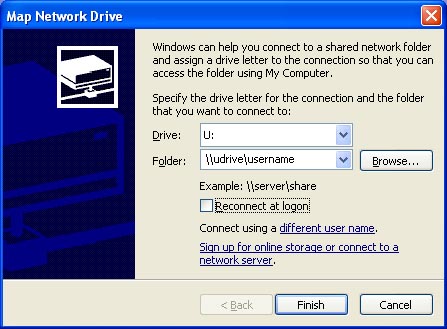
Commands for Publishing Web Pages to a Campus Account using your uDrive
What is the uDrive?
The uDrive is an extra storage area that provides additional disk space for campus users who wish to store their desktop files and folders on a remote server. This campus server houses all files and email messages that are sent to users' CSUN email accounts.
|
Note: Also available are step-by-step instructions for publishing a Web page using the following web authoring products: Dreamweaver, FrontPage, and Netscape Composer. |
Publishing to a uDrive using a PC
Mapping your Network Drive on your PC

- Right click the My Computer icon on your desktop, and select Map Network Drive... The "Map Network Drive" window appears.
- In the Drive: box, click the down arrow and select the U: drive from the list of available drive names for the drop down menu, the default drive name is Z:.
- Click in the Folder: text box and type \\udrive\xxxx where xxxx is you campus account user name, e.g. jsmith.
- Click Finish.
- In the Connect to uDrive window, type your campus user name and password, and click OK or press Enter.
- A window listing your files and folders, including your public_html folder (if you have created one) will be displayed in the My Computer window. You may copy, move, and delete flies to and from this drive, the same way you use any window on your PC.
The first time you map to the uDrive you will see the files that currently reside in your campus account. Many of these files may not be familiar to you. Never delete files with which you are unfamiliar, as they may cause problems to you account. Ignore these files and simply use the drive to copy, move, organize and navigate through your files, folder and drives.
Note: To activate your uDrive the first time, you must change your password. Go to http://www.csun.edu/account and change your current password. Your uDrive will the be recognized. This need only be done once.
Creating your Public Directory and Publishing to it
If you have already have a public_html directory, then all you need to do is to drag and drop the new/modified files into the folder and they will display on the Internet. To create a public_html folder, right-click in the mapped drive window and choose New/Folder. Name the folder public_html and it is ready to receive your files.Publishing to a uDrive using a Mac
Mapping your Network Drive on your PC
Under the Go menu on the blue apple menu bar at the
top of the display, choose Connect to Server.

In the Connect to Server window, type in the location
of the account that you wish to map. The correct format for the path
is smb://udrive.csun.edu/xxxx where xxxx is your campus account
user name. Then click the Connect button.

In the Authentication window, leave the Workgroup/Domain
box blank. Type in your campus Username and Password in
the boxes indicated. Then click the OK button.

The icon for your uDrive will appear on your desktop. Double-click it open to see its contents. If you have already have a public_html directory, then all you need to do is to drag and drop the new/modified files into the folder and they will display on the Internet. To create a public_html folder, open up the File pull down menu option on the menu bar at the top of the display and choose New Folder. Name the folder public_html and it is ready to receive your files.

Your Web Page Location (URL)
Once you've completed all the steps shown above, you'll probably want to look at your Web page online — and tell others where to find it.If your main Web page file is called index.html your Web page address is:
http://www.csun.edu/~account
where account is your account number (e.g., xyz12345 or hcxyz123). Make sure to include the tilde (~) character.If it is called something else (such as homepage.html), your Web page address is:
http://www.csun.edu/~account/filename
where account is your account number (e.g., xyz12345 or hcabc123) and filename is the name of your Web page file (homepage.html, for example). Again, make sure to include the tilde (~) character.May 1, 2004
Prepared by Chris Sales, User Support Services
ITR's technology training guides are the property of California State University, Northridge. They are intended for non-profit educational use only. Please do not use this material without citing the source.